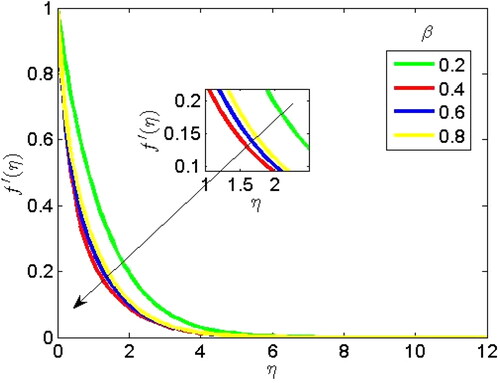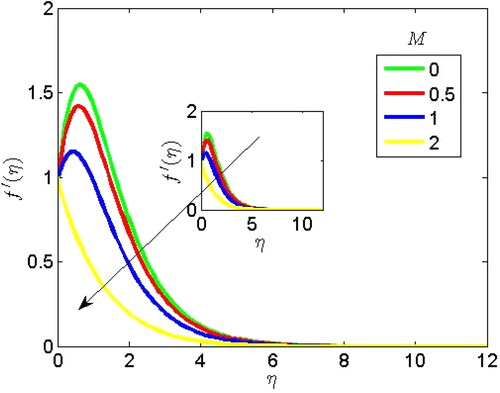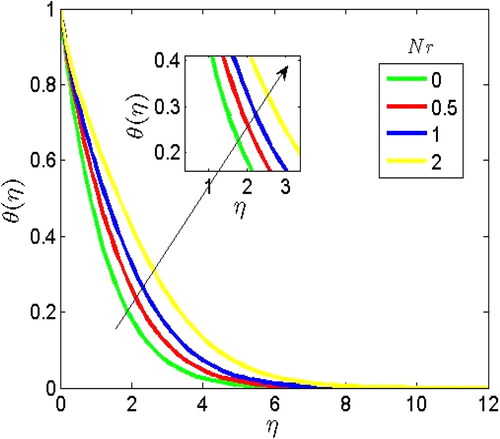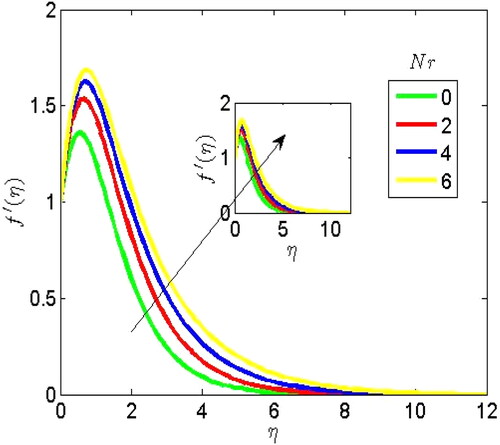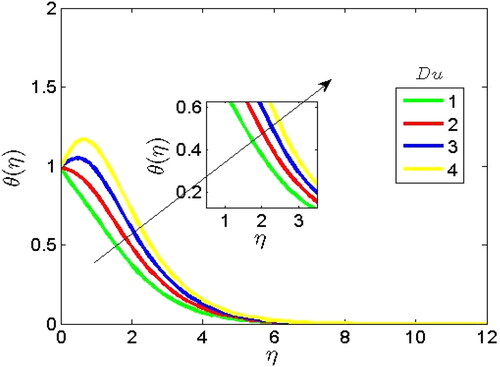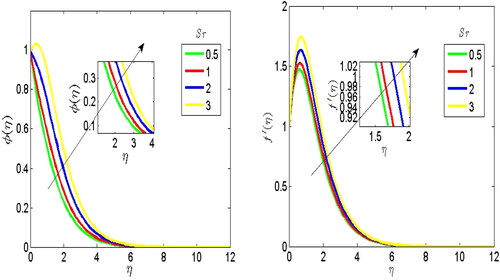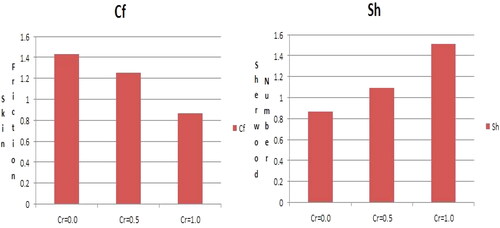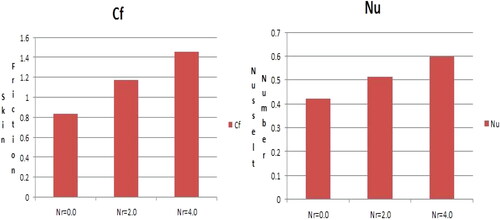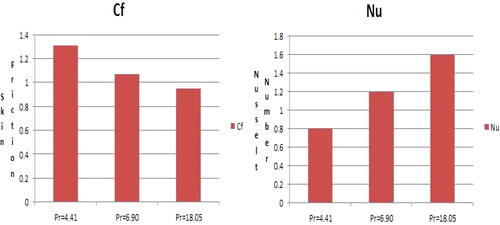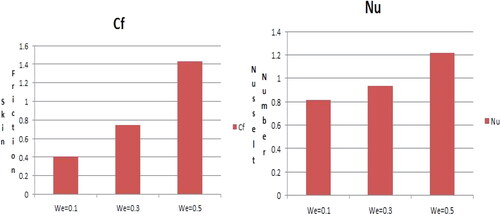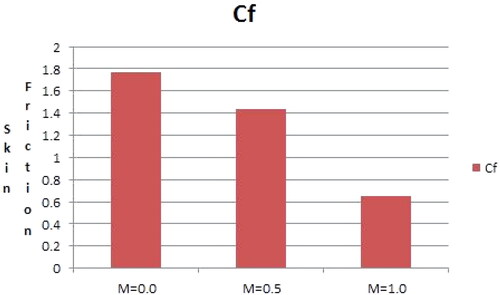 ?Mathematical formulae have been encoded as MathML and are displayed in this HTML version using MathJax in order to improve their display. Uncheck the box to turn MathJax off. This feature requires Javascript. Click on a formula to zoom.
?Mathematical formulae have been encoded as MathML and are displayed in this HTML version using MathJax in order to improve their display. Uncheck the box to turn MathJax off. This feature requires Javascript. Click on a formula to zoom.Abstract
The focus of this paper is to conduct research on MHD Casson-Williamson nanofluids flow over an inclined plate with the influence of thermal radiation and Soret-Dufour mechanisms using spectral collocation and statistical analysis. The simultaneous flow of Casson-Williamson non-Newtonian fluids in the presence of a magnetic field, Joule heating, chemical reaction, and viscous dissipation is modelled by utilizing partial differential equations (PDEs). These equations were transformed into coupled nonlinear ordinary differential equations by using an appropriate similarity variable. A numerical and statistical analysis was performed on the transformed equations to obtain significant effects of flow parameters on velocity, temperature, and concentration distributions. An increase in the value of the thermal radiation is observed to increase the fluid temperature, thermal condition, and thermal boundary layer thickness. An increased value of magnetic parameter was observed to decrease the fluid velocity. Due to a magnetic field and the dynamic plastic viscosity, the hydrodynamic boundary layer was observed to decline due to an increase in Casson parameter. The present study was compared with studies in the literature and found in good agreement.
1. Introduction
Studies on non-Newtonian fluids have become the focus of research in recent times. A non-Newtonian fluid is a fluid that does not obey Newton’s law of viscosity. Examples of such fluids are paints, ketchup, toothpaste, shampoos, sources, and colloidal solutions. Many of these fluids are complex. Due to the complexity and non-linearity of the fluids, researchers employed a numerical approach in solving their rheological equations. Non-Newtonian fluids find rheological applications in mechanical and chemical engineering phenomena. Casson non-Newtonian fluid finds application in food processing. The theory of Casson fluid motion past an inclined plate has been active in literature for the last few decades because of its applications in engineering and industry. A Casson rheological property is interesting among the non-Newtonian fluids. Examples of such fluids are ketchup, honey, blood, shampoos, and the flow of plasma. Nadeem, Ul Haq, and Lee (Citation2012) explored the MHD motion of a Casson liquid past an exponentially shrinking sheet. Sulochana and Poornima (Citation2019) considered unsteady MHD Casson liquid motion through a slanting plate with a hall current. Reddy (Citation2016) examined the MHD motion of Casson liquid past an exponentially slanting penetrable elongated surface with a chemically reacting and thermal radiating nature. Khalid, Khan, Khan, and Shafie (Citation2015) explored unsteady MHD free convection Casson fluid flow past a vertical plate. Das, Mahatha, and Nandkeolyar (Citation2015) elucidated Newtonian heating’s impact on unsteady hydromagnetic Casson fluid flow past a flat plate with mass and heat transport. In 2021, Ullah et al. (Citation2021) explored the unsteady MHD slip flow of Casson fluid through a penetrable medium with convective boundary conditions. Idowu and Falodun (Citation2020) examined the flow of two non-Newtonian fluids flowing through a penetrable plate. Recently, Falodun, Ayoade, and Odetunde (Citation2021) examined the positive and negative Soret-Dufour mechanisms on the unsteady flow of Newtonian fluids. The recent study by Oyelami, Ige, Saka-Balogun, and Adeyemo (Citation2021) explored the hydrodynamic boundary layer flow of pulsatile couple stress fluid. Oyelami and Falodun (Citation2021) looked at how changing temperatures affect the flow of water in the boundary layer.
The magnetic field plays a vital role in the analysis of thermo-physical fluid properties. Analysis of fluids such as plasma, liquid metals, and electrolytes does not have a high conductor of electricity until an external agent is used to enhance heat transfer. Electromagnetic force monitors fluid flow when the fluid is highly conductive. Nanofluids flow with magnetic fields and thermal radiation, which are of great importance in chemical, mechanical, and thermal engineering. Nanofluids are fluids containing nanometer-sized particles, which are called nanoparticles. Such fluids are colloidal suspensions of nanoparticles in a base fluid. The nanoparticles could be oxides, carbides, or carbon nanotubes. In the past few years, research on MHD nanofluids has gotten a lot of attention because of how important they are in bioscience and biomedical engineering.
Haroun, Sibanda, Mondal, and Motsa (Citation2015) investigated unsteady MHD mixed convection in a nanofluid past a stretchable or shrinking surface. Gireesha, Kumar, Ramesh, and Prasannakumara (Citation2018) elucidated nonlinear convective mass and heat transport of Oldroyd-B nanofluid past an elongated sheet. Jayachandra Babu and Sandeep (Citation2016) investigated MHD 3 D nanofluid slip motion past a slandering sheet with the influence of Brownian motion and thermophoresis. Gholinia, Gholinia, Hosseinzadeh, and Ganji (Citation2018) investigated ethylene glycol nanofluid flow through a circular cylinder under magnetic field influence. Khan, Gul, Khan, Bonyah, and Islam (Citation2017) explored the impact of solar radiation and heat generation on Carreau nanofluid past a stretching sheet with cash and carp improved coefficients. Anwar et al. (Citation2019) investigated the numerical examination of MHD Casson nanofluid flow under the Soret-Dufour mechanism. Mondal, Pal, Chatterjee, and Sibanda (Citation2018) examined mass transfer over an inclined plate with Soret-Dufour and a magnetic field. Raju, Sandeep, Sugunamma, Jayachandra Babu, and Ramana Reddy (Citation2016) studied MHD Casson fluid flow over an exponentially permeable stretching surface. Memon, Memon, Bhatti, and Shaikh (Citation2020) explored a combined simulation of non-Newtonian and Newtonian fluid flow. Zhou, Fan, Zheng, and Ma (Citation2021) recently examined grouting penetration because of grain distribution and grout-water interaction. Regression and stability analysis have been considered for nanofluid flow with magnetohydrodynamics by Jahan, Sakidin, Nazar, and Pop (Citation2018). Atif, Abbas, Rashid, and Emadifar (Citation2021) investigated the stagnation point flow of EMHD micropolar nanofluid with mixed convection and slip boundary. The significance of slip and radiative heat flux was investigated on MHD Maxwell nanofluid with non-Fourier and non-Fick laws in a porous medium. Rashid et al. (Citation2021) researched the effects of Ag-water and TiO2-water nanoparticles’ shapes on heat transfer and hybrid nanofluid flow toward stretching shrinking horizontal cylinders.
Free convective heat transport with thermal radiation is taken as a significant phenomenon in engineering systems due to its wide applications in solar energy collectors, heat exchangers, electronic cooling, and hydrocarbon recovery. Srinivasacharya, RamReddy, and Naveen (Citation2018) studied the effect of thermal radiation on the flow of nanofluid past an inclined wavy surface. Salawu and Dada (Citation2016) studied the radiative heat transport of incompressible laminar flow with the influence of an inclined magnetic field. The study by Kataria and Patel (Citation2016) examined the radiation and chemically reacting impacts on MHD Casson fluid flow in a penetrable medium. Srinivasacharya and Kumar (Citation2018) studied the double dispersion impact on nonlinear convective motion past an inclined non-Darcy porous medium. Naganthran et al. (Citation2021) demonstrated how bioconvection in a porous surface can enhance thermal transport during suction and injection. Hayat, Rashid, and Alsaedi (Citation2017) presented radiation effects on mixed convection motion which is induced by an inclined stretching cylinder. Alao, Fagbade, and Falodun (Citation2016) studied the flow of heat and mass transport of a chemically reacting fluid in the presence of thermal radiation and the Soret-Dufour mechanism. Idowu and Falodun (Citation2020) investigated the motion of non-Newtonian fluids through a vertical penetrable plate under the influence of variable thermal conductivity and viscosity. Ige (Citation2021) addressed the flow transport in the neighbourhood of stagnation; thermophoretic parameters translated to an escalation in momentum and thermal fields in a nanoparticle-mediated flow under the effect of the magnetic field. Rashid, Baleanu, Iqbal, and Abbas (Citation2020a) investigated the shape effect of nanosize particles on MHD nanofluid flow and heat transfer past a stretching sheet. In another study, Rashid et al. (Citation2020b) examined the marangoni boundary layer flow and heat transfer of graphene-water nanofluid with particle shape effects. Atif, Khan, Abbas, and Rashid (Citation2022) recently looked at bioconvection MHD tangent hyperbolic nanofluid flow with quartic chemical reaction past a paraboloid surface.
The present study is aimed at addressing the Linear and Quadratic Multiple Regressions Analysis on Magneto-Thermal and Chemical Reactions on the Casson-Williamson Nanofluids Boundary Layer Flow. The present study is an improvement on the study of Mondal et al. (Citation2018) by studying the simultaneous flow of Casson-Williamson nanofluids through an inclined plate. Also, the study of Raju et al. (Citation2016) was improved by extending the fluid flow to two non-Newtonian past an inclined plate. The significance of flow parameters such as joule heating and Soret-Dufour mechanisms, which were ignored in the study of Raju et al. (Citation2016), was discussed in this study. The uniqueness of the present analysis is the utilization of statistical and numerical analysis in studying the behaviour of flow parameters within the boundary layer. To the very best of our knowledge, no study in the literature has addressed the analysis of this type. Hence, the objectives of this paper are to:
Examine the effects of thermal radiation, Joule heating, Soret, and Dufour mechanisms on the flow of Casson MHD nanofluids past an inclined plate.
We explore linear and quadratic multiple regression analysis on the simultaneous flow of Casson-Williamson nanofluids past an inclined plate; and
Statistical graphs are used to elucidate the reaction of pertinent flow parameters on the quantity of engineering interest.
The present model is solved numerically by utilizing the Spectral collocation approach while linear and quadratic multiple regression analyses were conducted on the quantities of engineering interest. SCM is an iterative technique that employs the concept of Gauss-Seidel relaxation techniques to decouple systems of differential equations. It is hoped that the results will add to the results that have already been published.
2. Mathematical analysis
A two-dimensional, laminar, and incompressible fluid flow with nanoparticles past an inclined plate is considered. The inclined plate is flat and has a supporting surface tilted at an inclined angle. A practical example is a ramp used to load goods into a truck and also for a person walking up a pedestrian ramp (see ). The inclined angle is analyzed at an acute angle to the horizontal plate. The nanoparticle volume fraction from temperature and concentration is considered to be Also, the free stream concentration and temperature are and, respectively. The optically thin nanofluid is considered so that the Rosseland approximation is utilized in analyzing the radiative heat flux. An analysis based on thermal radiation and buoyancy effects is examined while the surface of the inclined plate is considered to be permeable to permit the passage of fluid wall suction or injection with significant consideration of Joule heating, viscous dissipation, and Soret-Dufour mechanisms. The Casson and tangent hyperbolic nanofluid motion is generated because of the stretching of the inclined plate surface. The magnetic field of uniform strength is executed in the y-axis direction. The model species concentration is considered to be high enough such that the Soret and Dufour scenarios cannot be ignored. A scenario in which a cooled inclined plate is considered The model of two non-Newtonian Casson and tangent hyperbolic fluids is examined in this research, and it involves two fluid parameters. Based on Fredrickson (Citation1964) and the definition of viscosity given in Idowu and Falodun (Citation2020) as the flow constitutive equations for Casson are explained as follows:
(1)
(1)
Where the fluid yield stress is and mathematically written as:
(2)
(2)
defines plastic dynamic viscosity,
defines component product of deformation rate with itself and
defines deformation rate and
defines critical value according to the model of Casson fluid. The Casson liquid motion where
it can be defined as:
(3)
(3)
evaluating Equation(2)
(2)
(2) into Equation(3)
(3)
(3) , the kinematic viscosity is now subject to plastic dynamic viscosity
the density is
and the Casson term
resulted to:
(4)
(4)
The Boussinesq approximation is considered to be valid such that the boundary layer approximation is explored. Hence, the following governing equations are derived based on the assumptions above (see Mondal et al., Citation2018; Raju et al., Citation2016):
(5)
(5)
(6)
(6)
(7)
(7)
(8)
(8)
Subject to the boundary constraints:
(9)
(9)
(10)
(10)
and
represents the relations
and
In the definition of
and
is the free stream which automatically satisfy the continuity equation. Similarity variables are define as
(11)
(11)
Using EquationEq. (11)(11)
(11) on EquationEqs. (6)–(8) subject to Equation(9)
(9)
(9) and Equation(10)
(10)
(10) to obtain:
(12)
(12)
(13)
(13)
(14)
(14)
Subject to:
(15)
(15)
(16)
(16)
The control parameters are defines as follows:
are the Magnetic parameter, Prandtl number, thermal radiation parameter, Eckert number, Dufour number, Schmidt number, Soret number, chemical reaction parameter, Brownian motion parameter, Thermophoresis parameter, and Lewis number.
The skin friction (Cf), Sherwood number (Sh) and Nusselt number (Nu) are defined as follows:
Where
3. Chebyshev spectral collocation method
This section explains the collocation approach base on Chebyshev techniques. This method is employed to obtain the numerical solutions to EquationEqs. (12)–(13) with the associated boundary conditions Equation(15)(15)
(15) and Equation(16)
(16)
(16) in the domain [0,L]. The domain [0,L] is hereby simplified into [−1, +1] using the following algebraic function.
(17)
(17)
Also, to approximate and
from the equation above, the shifted Chebyshev polynomials are define as
(18)
(18)
(19)
(19)
(20)
(20)
We proceed to obtain the Chebyshev Gauss-Lobatto nodes to [0,L] as follows:
(21)
(21)
Where N is the number of collocationused in this paper as 100. An initial function for and
are assumed to satisfies the boundary conditions. Hence,
and
are defined as:
(22)
(22)
3.1. Convergence of the method
In applying spectral collocation method, a domain computational value of L = 12 is taking in the direction. The use of L = 12 was found to be accurate for all physical parameters. Changing this value for L does not change the outcome to a reasonable extent. All through the numerical computations, the number of collocation employed is N = 100. An iterative computations were done until a desired tolerance level
was obtained. The tolerance level is calculated subject to norm as follows:
(23)
(23)
To be certain that the outcome of the present analysis is accurate, a very small value of was utilized. Also, the step size was considered to be small so as to ensure convergence of the flow engineering quantities of interest.
3.2. Statistical analysis
The procedures of linear and quadratic regressions employed in this study are as follows (see Memon et al., Citation2020).
(24)
(24)
Hence,
(25)
(25)
The study proceeds the analysis of best quadratic fit using the equation:
(26)
(26)
Here A, B, and C are calculated by employing:
(27)
(27)
To analyse the linear regression to fit the straight line equation is defined as:
(28)
(28)
Where a and b are defined as follows:
(29)
(29)
The linear and quadratic regressions are further explained in this study to estimate the reduced Nusselt number to examine the impact of Nb and Nt (see Jahan et al., Citation2018). The corrections linear and quadratic regressions are defined as follows:
(30)
(30)
(31)
(31)
Where coefficients of linear and quadratic regressions are and
respectively. The regression equations are valid within the range [0,0.5]. The expected maximum error is gotten using
4. Validation of the code
To check the accuracy and correctness of the present analysis, the outcomes of the present model is compared with the previous works of Mondal et al. (Citation2018) when and Raju et al. (Citation2016) when
The validation as shown in and are found in good correlation. Therefore, the accuracy and correctness of the present result is good for further study on the dynamics of thermo-physical parameters on non-Newtonian fluids in isothermal medium.
Table 1. Comparison of the present study with the published work of Mondal et al. (Citation2018) when
Table 2. Skin Friction of the present study compared with the published work of Raju et al. (Citation2016) when
5. Results and discussion
This paper examined the dynamics of MHD Casson and tangent hyperbolic nanofluid past an inclined vertical plate under the influence of Brownian motion, thermophoresis and Soret-Dufour. The model constituted of partial differential equations. The PDEs was transformed into ODE and solved numerically by utilizing SRM. The impact of all flow parameters on velocity, temperature and concentration are presented in graphs. The default values for flow parameters are defined as and
Hence, all computations are based on the above stated values except stated.
The effect of the Casson parameter on the velocity profile is depicted in . Increasing the value of declines the velocity profile, as illustrated in . Our experiment shows that the flow of Casson nanofluid in the presence of Lorentz force is responsible for degenerating the fluid motion. In addition, the yield exhibiting fluid possesses a plastic dynamic viscosity. Viscosity gives resistance to fluid flow. Hence, the plastic dynamic viscosity, which is considered constant in this study, is another yardstick for measuring the fluid velocity and the entire hydrodynamic boundary layer. This means that an amplified plastic dynamic viscosity produces greater resistance to the flow. depicts the contribution of the magnetic parameter to the velocity figure. A considerable value of the magnetic parameter (M) is observed to decrease the velocity profile. When current is induced due to the electrically conducting fluid motion subjected to a magnetic field, the Lorentz force is produced. The Lorentz force acts like a resistive force, which slows down the motion of the fluid. The magnetic field strength is a device which gives rise to the Lorentz force and thereby slows down the motion of an electrically conducting fluid. In the problem of heat and mass transfer, the MHD is an important device which plays a vital role in MHD accelerators, MHD plasma, highly polymer additives, etc. However, the outcome in is in good agreement with the result of Idowu and Falodun (Citation2020).
illustrates the contribution of the thermal radiation parameter (Nr) on the velocity and temperature profile. Thermal radiation defines the electromagnetic radiation produced as a result of the thermal motion of nanoparticles. Hence, all nanoparticles with a high temperature greater than absolute zero emit thermal radiation. A considerable value of Nr is detected to elevate the temperature and velocity profile. An increase in the thermal radiation increases the thermal energy, which then enhances the fluid thermal condition and thermal boundary layer thickness. Thermal radiation has a significant impact on flow when and where it occurs. Hence, thermal radiation plays a vital role in thermal engineering. depicts the impact of Brownian motion (Nb) on the velocity and temperature profiles. An increased value of Nb is detected to increase the velocity and temperature profiles. The Brownian movement of the nanoparticles allows all particles to be in constant motion. However, the momentum of the nanofluids remains null over time. This means the kinetic energies posed by molecular Brownian motions along with molecular vibrations sum up to lead to internal energy. Physically, when the particles are in constant motion, all particles will not be able to settle down, and this leads to the colloidal solution stability. Hence, increasing the Brownian motion parameter enhances the velocity of the fluid particles (the random collision). Also, as the fluid collides with each other during the Brownian movement, they get warmed up, and hence the temperature and the entire boundary layer thickness increase.
Figure 5. (a) Effect of Brownian motion on the velocity profile. (b) Effect of Brownian motion on the temperature profile.
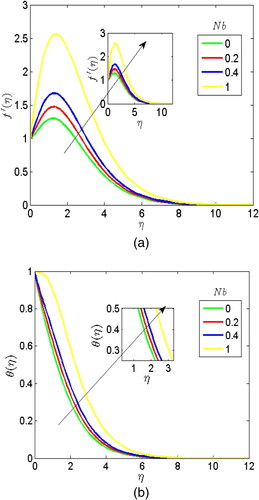
shows the impact of pertinent flow parameters such as We, M, Cr, Nr, and Pr on the local skin friction, Nusselt and Sherwood numbers. An increase in the value of We is observed to increase the local skin friction and Nusselt number but has no significant effect on the Sherwood number. A higher value of M is noticed to decrease the local skin friction but remains constant on Nusselt and Sherwood numbers. However, a higher value of Cr is observed to speed up the rate of mass transfer. In , an increase in Nr is observed to elevate the skin friction and Nusselt number. The effect of Nr on Sherwood number is negligible. With an increase in Pr, skin friction is observed to degenerate. Also, a higher value of Pr is observed to speed up the rate of heat transfer. In , an increment in the value of Ec, Du, Nb, and Nt is observed to enhance the local skin friction and Nusselt number. This shows that these parameters speed up the rate of heat transfer within the boundary layer.
Table 3. Contribution of Soret parameter on the velocity and concentration profiles.
Table 4. Contributions of Ec, Du, Nb, Nt, Sc and Sr on the local skin friction (Cf), Nusselt number and Sherwood number.
and illustrate the impact of the thermophoresis parameter (Nt) on the velocity and temperature figure. A considerable value of Nt is observed to elevate the velocity and temperature profiles. The thermophoresis is the migration of cold particles to a hot region. It is a phenomenon detected in mixtures of mobile particles where different types of particles exhibit different responses to the temperature gradient force. Hence, an increase in the thermophoresis parameter increases the temperature gradient force by enhancing the fluid temperature as well as thermal boundary layer thickness. and depicts the impact of the Prandtl number on the velocity and temperature profile. A considerable values of Prandtl number elevate the velocity and temperature figures. Prandtl number is the ratio of fluid viscosity to thermal conductivity. Physically, if the viscosity is greater than thermal conductivity, the Prandtl number becomes very high and elevates the velocity and temperature figure. Consider that,
it shows that the fluid is highly conducive.
Figure 6. (a) Contribution of thermophoresis parameter on the velocity profiles. (b) Contribution of thermophoresis parameter on the temperature profiles.
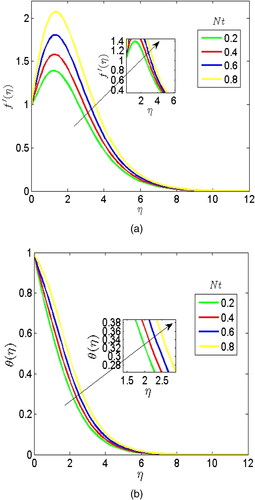
and illustrates the impact of the chemical reaction parameter on the velocity and concentration figures. A considerable value of Cr is observed to degenerate the velocity and concentration figures. A spontaneous chemical destruction is observed to cause a delay to the nanoparticles within the boundary layer. and depicts the impact of Schmidt number (Sc) on the velocity and concentration figures. A considerable value of the Schmidt number is detected to decrease the velocity and concentration figures. The dimensionless Schmidt number is responsible for the control of the rate of mass transport effect. This means,
signifies that there is no specie equation and the model hereby becomes the thickness of the hydrodynamic boundary layer. Physically, Sc explains the relationship between the mass transfer and the thickness of the hydrodynamic boundary layer. and illustrate the effect of Eckert number (Ec) on the velocity and temperature profiles. A considerable value of the Eckert number is observed to increase the velocity and temperature profiles. Physically, increase in Ec resulted to increase in heat energy with the boundary fluid layer. This heat energy produced by Ec is stored for existence of frictional heating.
Figure 7. (a) Contribution of Prandtl number on the velocity profiles. (b) Contribution of Prandtl number on the temperature profiles.
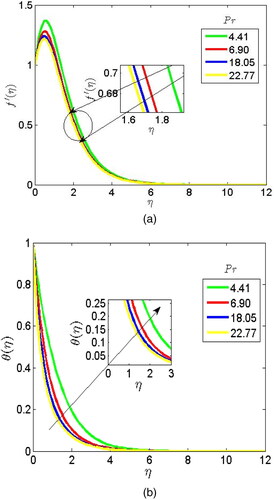
Figure 8. (a) Contribution of chemical reaction parameter on velocity profile. (b) Contribution of chemical reaction parameter on concentration profile.
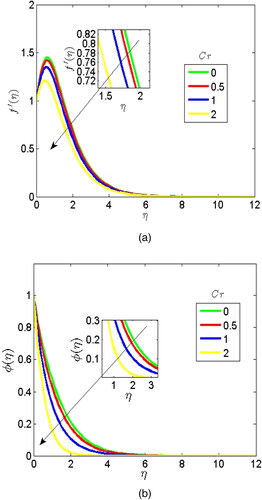
Figure 9. (a) Contribution of Schmidt number on the velocity profiles. (b) Contribution of Schmidt number on the concentration profiles.
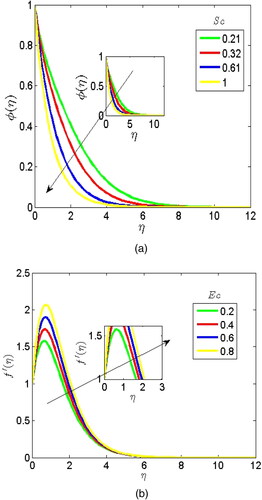
The phenomenon of combined effects of Soret and Dufour are studied in this paper. They are both of second order and are often neglected by many scholars in literature. The present study elucidates the combined effects of Soret and Dufour because of the usefulness in isotope separation. and b depicts the impact of Dufour parameter (Du) on the velocity and temperature profiles. A considerable value of Du causes an elevation to the velocity and temperature profiles. Physically, the Dufour term is added to the energy equation in the model of heat and mass transport. If is of second order and a function of concentration. As the value of Du increases, the fluid nanoparticles diffuses to the thermal region and hereby causes increase to the thickness of the thermal boundary layer.
Figure 10. (a) Contribution of Eckert number on the velocity profile. (b) Contribution of Eckert number on the temperature profile.

illustrates the effect of the Soret parameter on the velocity and concentration figures. An increase in the value of Soret parameter (Sr) raises the velocity and concentration figures. Physically, the Soret term is a function of temperature but added to the specie equation in the problem of heat and mass transport. The nanoparticles diffuse from the thermal region to the cold region. As a result of the heat energy within the environment, the movement of the nanofluids particles becomes very fast as a result of increase in velocity. On the other hand, as the nanoparticles collides together, their temperature increases together with the thermal boundary layer thickness.
shows the statistical analysis of parameters on quantities of engineering interest. The bar charts of Cr on the skin friction and Sherwood number is illustrated in . An increase in Cr is noticed to decrease the skin friction while an increase in Cr is noticed to increase the Sherwood number. This shows the statistical approach of multiple regression, that is, the analysis of the relationship between one dependent variable and several independent variables. The chemical process occurs as a result of collision of the fluid particles. shows an increase in Cf and Nu due to increase in thermal reaction. A thermal process finds significant when temperature is high. The thermal process of fluid particles is hereby noticed to enhance the thermal and hydrodynamic boundary layer. The statistical charts in shows that increase in Pr decrease the skin friction while the Nusselt number increases. In the analysis, the fluid viscosity is detected to be in correlation with fluid thermal conductivity. The outcome in shows that the momentum gathered by fluid particles reduces due to higher Pr while the thermal transport capacity of fluids possess higher temperature due to higher Pr. illustrated the regression analysis of We against Cf and Nu respectively. At higher We, both Cf and Nu are detected to increase. This means that increase in We raises the hydrodynamic and thermal boundary layer respectively. shows the reaction of M on the skin friction. The outcomes in shows that, increase in M decreases the skin friction on the statistical chart. The magnetic field intensity produced flux density which adds to the strength of Lorentz force due to increase in the value of M. The Lorentz force reduces the motion of an electrically conducting fluid. shows the statistical analysis of the present outcomes and that of Mondal et al. (Citation2018) and Raju et al. (Citation2016). The outcome of the present analysis as shown in is found to be in good agreement with the previously published works.
Figure 18. Statistical analysis of the present study and the published work of Mondal et al. (Citation2018).
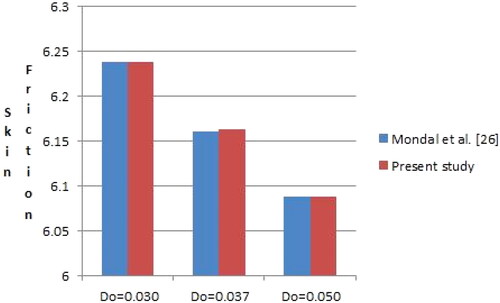
Figure 19. Statistical analysis of the present study and the published work of Raju et al. (Citation2016).
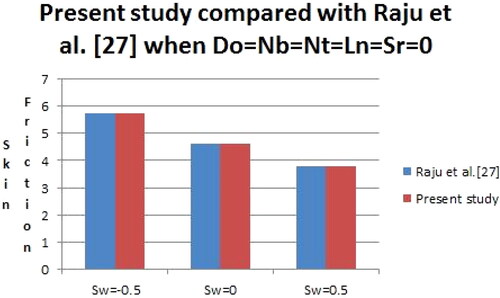
Figure 20. Statistical analysis of the present study and the published work of Mondal et al. (Citation2018).
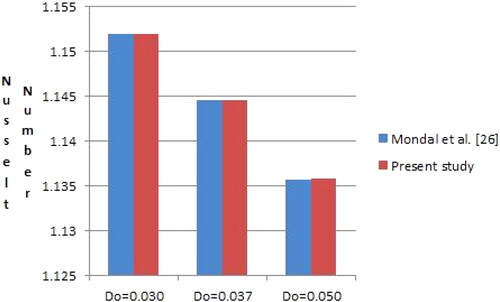
6. Conclusion
This study explored the significant effects of thermal radiation, Joule heating, and chemical reaction on the MHD motion of Casson-Williamson nanofluids over an inclined plate. Statistical and numerical analysis for constant thermo-physical properties is considered to conduct a parametric study on the temperature, velocity, and concentration. Section one of this paper presents the introduction; section two presents the mathematical analysis of the problem; section three explains the method approach; the validation of the code is presented in section four; section five presents the results and discussion; and the conclusions are presented in section six, followed by references. From , a simultaneous flow of Casson-Williamson non-Newtonian fluids was mixed together with the boundary layer. The mixture of these different types of fluids was observed to lower the thermal conductivity and viscosity within the boundary layer. As a result of this fact, an increase in the Casson parameter lowers the fluid velocity and the entire boundary layer thickness. The presence results show that the imposed magnetic field produces a Lorentz force, which reduces the fluid velocity and the local skin friction. The present outcomes explain the effect of radiation parameters, and it is observed that a considerable value of radiation parameter brings an increase to the fluid velocity and temperature profiles. As the value of the chemical reaction parameter increases, the destructive nature of the effects is observed by the decrease in the velocity and concentration profiles. It is observed that the velocity and temperature profiles increase due to a considerable value of the Dufour parameter. The thermal energy and thermal condition of the fluid nanoparticles are observed to increase due to the high value of the thermal radiation parameter. When the Weissenberg number is high, it is seen to increase the friction on the surface and the rate of heat transfer.
The present outcomes are hoped to be useful in thermal engineering owing to the presence of thermal radiation. Also, MHD applications are found in MHD accelerators, MHD plasma, MHD power generators, and hall accelerators. This study is hoped to be useful in the separation of isotopes because of the consideration of Soret-Dufour mechanisms in the present model of heat and mass transport over an inclined plate.
| Nomenclature Greek Letter | ||
| = | dimensionless distance (-) | |
| = | dimensionless temperature (-) | |
| = | dimensionless concentration (-) | |
| = | fluid dynamic viscosity (m2 s−1) | |
| = | Casson parameter (-) | |
| = | electrical conductivity (-) | |
| = | magnetic field strength (-) | |
| = | fluid density (kgm−3) | |
| = | thermal conductivity (m2s−1) | |
| = | angle of inclination | |
| = | coefficient of nanofluids | |
| Notations | ||
| = | volumetric coefficient of thermal expansion (K−1) | |
| = | free stream temperature (K) | |
| = | volumetric coefficient of concentration expansion (m−3Kmol) | |
| = | free stream concentration (mol) | |
| = | specific heat capacity at constant pressure (JKg−1K−1) | |
| = | mass diffusivity (m2s−1) | |
| = | thermal diffusion ratio (-) | |
| = | coefficient of chemical reaction (-) | |
| = | mean fluid temperature (-) | |
| = | wall temperature (K) | |
| = | wall concentration (mol) | |
| = | suction velocity | |
| Symbols | ||
| g | = | acceleration due to gravity |
| T | = | fluid temperature (K) |
| B | = | constant (-) |
| f | = | dimensionless velocity (-) |
| C | = | fluid concentration (mol) |
| u,v | = | velocity components in x, and y-directions respectively |
Disclosure statement
No potential conflict of interest was reported by the authors.
References
- Alao, F. I., Fagbade, A. I., & Falodun, B. O. (2016). Effects of thermal radiation, Soret and Dufour on an unsteady heat and mass transfer flow of a chemically reacting fluid past a semi-infinite vertical plate with viscous dissipation. Journal of the Nigerian Mathematical Society, 35(1), 142–158. doi:10.1016/j.jnnms.2016.01.002
- Anwar, M. I., Rafique, K., Misiran, M., Khan, I., Alharbi, S. O., Thounthong, P., & Nisar, K. S. (2019). Numerical solution of Casson nanofluid flow over a non-linear inclined surface with Soret and Dufour effects by Keller-box method. Frontiers in Physics, 7, 139. doi:10.3389/fphy.2019.00139
- Atif, S. M., Abbas, M., Rashid, U., & Emadifar, H. (2021). Stagnation point flow of EMHD micropolar nanofluid with mixed convection and slip boundary. Complexity, 2021, 1–13. doi:10.1155/2021/3754922
- Atif, S. M., Khan, W. A., Abbas, M., & Rashid, U. (2022). Bioconvection mangnetohydrodynamic tangent hyperbolic nanofluid flow with quartic chemical reaction past a paraboloid surface. Computer Modeling in Engineering & Sciences, 130(1), 205–220. doi:10.32604/cmes.2022.017304
- Das, M., Mahatha, B. K., & Nandkeolyar, R. (2015). Mixed convection and nonlinear radiation in the stagnation point nanofluid flow towards a stretching sheet with homogenous-heterogeneous reactions effects. Procedia Engineering, 127, 1018–1025. doi:10.1016/j.proeng.2015.11.451
- Falodun, B. O., Ayoade, A. A., & Odetunde, O. (2021). Positive and negative soret and dufour mechanism on unsteady heat and mass transfer flow in the presence of viscous dissipation, thermal and mass buoyancy. Australian Journal of Mechanical Engineering, 1–14. doi:10.1080/14484846.2021.1938950
- Fredrickson, A. G. (1964). Principles and applications of rheology. Englewood Cliffs (NJ): Prentice-Hall.
- Gholinia, M., Gholinia, S., Hosseinzadeh, K., & Ganji, D. D. (2018). Investigation on ethylene glycol Nano fluid flow over a vertical permeable circular cylinder under effect of magnetic field. Results in Physics, 9, 1525–1533. doi:10.1016/j.rinp.2018.04.070
- Gireesha, B. J., Kumar, K. G., Ramesh, G. K., & Prasannakumara, B. C. (2018). Nonlinear convective heat and mass transfer of Oldroyd-B nanofluid over a stretching sheet in the presence of uniform heat source/sink. Results in Physics, 9, 1555–1563. doi:10.1016/j.rinp.2018.04.006
- Haroun, N. A., Sibanda, P., Mondal, S., & Motsa, S. S. (2015). On unsteady MHD mixed convection in a nanofluid due to a stretching/shrinking surface with suction/injection using the spectral relaxation method. Boundary Value Problems, 2015(1), 1–17. doi:10.1186/S13661-015-0289-5
- Hayat, T., Rashid, M., & Alsaedi, A. (2017). MHD convective flow of magnetite-Fe3O4 nanoparticles by curved stretching sheet. Results in Physics, 7, 3107–3115. doi:10.1016/j.rinp.2017.08.015
- Idowu, A. S., & Falodun, B. O. (2020). Effects of thermophoresis, Soret-Dufour on heat and mass transfer flow of magnetohydrodynamics non-Newtonian nanofluid over an inclined plate. Arab Journal of Basic and Applied Sciences, 27(1), 149–165. doi:10.1080/25765299.2020.1746017,
- Idowu, A. S., & Falodun, B. O. (2020). Variable thermal conductivity and viscosity effects on non-Newtonian fluids flow through a vertical porous plate under Soret-Dufour influence. Mathematical and Computers Simulation, 177, 358–384. doi:10.1016/j.matcom.2020.05.001
- Ige, E. O. (2021). Analytical simulation of nanoparticle-embedded blood flow control with magnetic field influence through spectra homotopy analysis method. International Journal of Modern Physics B, 35(22), 1–17. doi:10.1142/S021797922150226X
- Jahan, S., Sakidin, H., Nazar, R., & Pop, I. (2018). Analysis of heat transfer in nanofluid past a convectively heated permeable stretching/shrinking sheet with regression and stability analyses. Results in Physics, 10, 395–405. doi:10.1016/j.rinp.2018.06.021
- Jayachandra Babu, M., & Sandeep, N. (2016). MHD non-Newtonian fluid flow over a slendering stretching sheet in the presence of cross-diffusion effects. Alexandria Engineering Journal, 55(3), 2193–2201. doi:10.1016/j.aej.2016.06.009
- Kataria, H. R., & Patel, H. R. (2016). Radiation and chemical reaction effects on MHD Casson fluid flow past an oscillating vertical plate embedded in porous medium. Alexandria Engineering Journal, 55(1), 583–595. doi:10.1016/j.aej.2016.01.019
- Khalid, A., Khan, I., Khan, A., & Shafie, S. (2015). Unsteady MHD free convection flow of Casson fluid past over an oscillating vertical plate embedded in a porous medium. Engineering Science and Technology: An International Journal, 18(3), 309–317. doi:10.1016/j.jestch.2014.12.006
- Khan, N. S., Gul, T., Khan, M. A., Bonyah, E., & Islam, S. (2017). Mixed convection in gravity-driven thin film non-Newtonian nanofluids flow with gyrotactic microorganisms. Results in Physics, 7, 4033–4049. doi:10.1016/j.rinp.2017.10.017
- Memon, A. A., Memon, M. A., Bhatti, K., & Shaikh, G. M. (2020). Finite element simulation of Newtonian and non-Newtonian fluid through the parallel plates affixed with single screen. European Journal of Pure and Applied Mathematics, 13(1), 69–83. doi:10.29020/nybg.ejpam.v1i1.3586
- Mondal, H., Pal, D., Chatterjee, S., & Sibanda, P. (2018). Thermophoresis and Soret-Dufour on MHD mixed convection mass transfer over an inclined plate with non-uniform heat source/sink and chemical reaction. Ain Shams Engineering Journal, 9(4), 2111–2121. doi:10.1016/j.asej.2016.10.015
- Nadeem, S., Ul Haq, R., & Lee, C. (2012). MHD flow of a Casson fluid over an exponentially shrinking sheet. Scientia Iranica, 19(6), 1550–1553. doi:10.1016/j.scient.2012.10.021
- Naganthran, K., Md Basir, M. F., Thumma, T., Ige, E. O., Nazar, R., & Tlili, I. (2021). Scaling group analysis of bioconvective micropolar fluid flow and heat transfer in a porous medium. Journal of Thermal Analysis and Calorimetry, 143(3), 1943–1955. doi:10.1007/s10973-020-09733-5
- Oyelami, F. H., & Falodun, B. O. (2021). Heat and mass transfer of hydrodynamic boundary layer flow along a flat plate with the influence of variable temperature and viscous dissipation. International Journal of Heat and Technology, 39(2), 441–450. doi:10.18280/ijht.390213
- Oyelami, F. H., Ige, E. O., Saka-Balogun, O. Y., & Adeyemo, O. A. (2021). Study of heat and mass transfer to magnetohydrodynamic (MHD) pulsatile couple stress fluid between two parallel porous plates. Instrumentation Mesure Métrologie, 20(4), 179–185. doi:10.18280/i2m.200401
- Raju, C. S. K., Sandeep, N., Sugunamma, V., Jayachandra Babu, M., & Ramana Reddy, J. V. (2016). Heat and mass transfer in magnetohydrodynamic Casson fluid over an exponentially permeable stretching surface, Engineering Science and Technology. An International Journal, 19, 45–52.
- Rashid, U., Baleanu, D., Iqbal, A., & Abbas, M. (2020a). Shape effect of nanosize particles on magnetohydrodynamic nanofluid flow and heat transfer over a stretching sheet with entropy generation, entropy. Entropy, 22(10), 1171. doi:10.3390/e22101171
- Rashid, U., Baleanu, D., Liang, H., Abbas, M., Iqbal, A., & Rahman, J. u (2020b). Marangoni boundary layer flow and heat transfer of graphene–water nanofluid with particle shape effects. Processes, 8(9), 1120. doi:10.3390/pr8091120
- Rashid, U., Liang, H., Ahmad, H., Abbas, M., Iqbal, A., & Hamed, Y. S. (2021). Study of (Ag and TiO2)/water nanoparticles shape effect on heat transfer and hybrid nanofluid flow toward stretching shrinking horizontal cylinder. Results in Physics, 21(2021), 103812. doi:10.1016/j.rinp.2020.103812
- Reddy, P. B. A. (2016). Magnetohydrodynamic flow of a Casson fluid over an exponentially inclined permeable stretching surface with thermal radiation and chemical reaction. Ain Shams Engineering Journal, 7(2), 593–602. doi:10.1016/j.asej.2015.12.010
- Salawu, S. O., & Dada, M. S. (2016). Radiative heat transfer of variable viscosity and thermal conductivity effects on inclined magnetic field with dissipation in a non-Darcy medium. Journal of the Nigerian Mathematical Society, 35(1), 93–106. doi:10.1016/j.jnnms.2015.12.001
- Srinivasacharya, D., & Kumar, P. V. (2018). Effect of thermal radiation on mixed convection of a nanofluid from an inclined wavy surface embedded in a non-Darcy porous medium with wall heat flux. Propulsion and Power Research, 7(2), 147–157. doi:10.1016/j.jppr.2018.05.002
- Srinivasacharya, D., RamReddy, C., & Naveen, P. (2018). Double dispersion effect on nonlinear convective flow over an inclined plate in a micropolar fluid saturated non-Darcy porous medium. Engineering Science and Technology: An International Journal, 21(5), 984–995. doi:10.1016/J.JESTCH.2018.07.012.
- Sulochana, C., & Poornima, M. (2019). Unsteady MHD Casson fluid flow through vertical plate in the presence of Hall current. SN Applied Sciences, 1(12), 2019112. doi:10.1007/s42452-019-1656-0
- Ullah, A., Selim, M. M., Abdeljawad, T., Ayaz, M., Mlaiki, N., & Ghafoor, A. (2021). A magnetite–water-based nanofluid three-dimensional thin film flow on an inclined rotating surface with non-linear thermal radiations and couple stress effects. Energies, 14(17), 5531. doi:10.3390/en14175531
- Zhou, M., Fan, F., Zheng, Z., & Ma, C. (2021). Modeling of grouting penetration in porous medium with influence of grain distribution and grout-water interaction. Processes, 10(1), 77. doi:10.3390/pr/0010077


